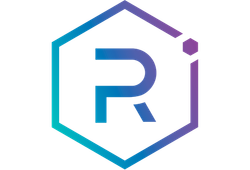
Stop overpaying - start transferring money with Ogvio. Sign up, invite friends & grab Rewards now! 🎁
Navigating the world of crypto trading can sometimes feel like discovering a hidden universe of opportunities. If you’ve dabbled with giants like Binance, Kraken, or Bybit, you’re already familiar with centralized powerhouses. But what if there’s a way to trade with flexibility, speed, and full control over your assets? That’s where Raydium steps in—a decentralized exchange redefining how traders interact with liquidity and innovation.
This Raydium review dives into what sets it apart. Built on the lightning-fast Solana blockchain, Raydium offers a seamless trading experience, complete with deep liquidity pools and advanced yield farming opportunities. Whether you’re looking for a new frontier in crypto or simply want to try out the sleek Raydium exchange app, this platform makes decentralization feel effortless.
With crypto growing more competitive by the second, exploring alternatives like Raydium could give you a serious edge. But is it the right fit for you? Let’s break it down.
Verdict at a glance: Raydium stands out as an innovative decentralized exchange, combining AMM efficiency with order book liquidity for optimal trades. Its concentrated liquidity pools, staking opportunities, and competitive fees make it appealing to both traders and liquidity providers. However, limited accessibility for certain regions and past security concerns may deter some users. With its user-friendly interface and robust features, Raydium is a solid choice for those ready to explore DeFi but it requires careful consideration of its risks.
Pros
- High performance with Solana
- Unique hybrid AMM design
- Low transaction fees
- Extensive educational resources
- Earning features
Cons
- Past security concerns
- Limited accessibility in some countries
Table of Contents
- 1. What is Raydium?
- 1.1. Raydium’s Position in the Crypto Landscape
- 2. Is Raydium Safe?
- 3. Raydium Review: PROS
- 3.1. High Performance with Solana
- 3.2. Unique Hybrid AMM Design
- 3.3. Yield Opportunities
- 3.4. Low Transaction Fees
- 3.5. Extensive Educational Resources
- 4. Raydium Review: CONS
- 4.1. Past Security Concerns
- 4.2. Limited Accessibility
- 5. Raydium Fees
- 5.1. Trading Fees for AMM Pools
- 5.2. Concentrated Liquidity Pools (CLMM)
- 5.3. RAY Buybacks and Treasury
- 6. Raydium Features
- 6.1. Standard Coin Swap
- 6.2. Concentrated Liquidity Pools
- 6.3. RAY Staking
- 7. How to Trade on Raydium
- 8. Conclusions
What is Raydium?
Raydium is like the Swiss Army knife of decentralized trading. At its core, it’s an automated market maker (AMM) built on the ultra-fast Solana blockchain. In case you don’t know, an AMM is a type of decentralized exchange that uses algorithms to set token prices and enable trading directly from liquidity pools, without needing a traditional order book[1] or middleman.
What makes it truly unique is its hybrid approach, which combines AMM functionality with access to central limit order books—a game-changer for liquidity sharing.
This brings us to the Raydium Protocol, the engine behind all the action. Unlike traditional AMMs that keep liquidity siloed, Raydium’s design was revolutionary at launch. It allowed idle liquidity in its pools to be shared with central limit order books, ensuring deeper liquidity and tighter spreads.

Initially, Raydium’s integration with the Serum DEX was its standout feature. Serum’s order books amplified Raydium’s liquidity, making it a go-to for traders. However, when Serum ceased operations, Raydium adapted by shifting its focus to self-reliance and enhancing its AMM capabilities. While Raydium’s hybrid AMM pools now operate in "Swap Only" mode, the platform remains an innovation hub for DeFi enthusiasts.
If you’re diving into the Raydium exchange app for the first time, you’ll quickly notice how seamlessly it delivers on speed and user control. This Raydium review wouldn’t be complete without recognizing how the platform continues to evolve in a rapidly changing DeFi landscape.
Raydium’s Position in the Crypto Landscape
Raydium stands out as one of the top decentralized exchanges, especially when considering its impressive trading volume. At the time of writing this Raydium review, the platform recorded a staggering 24-hour trading volume of $1,136,785,765.
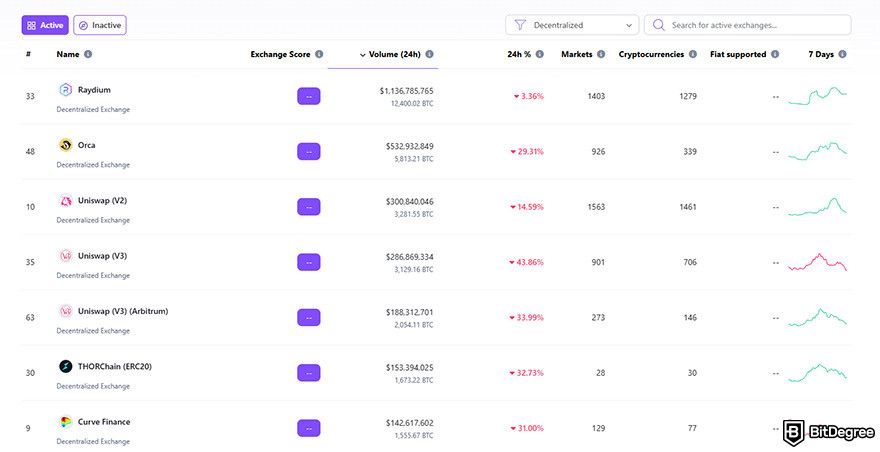
This makes it the DEX with the highest trading volume in that timeframe, beating big names like Uniswap and Curve. Additionally, Raydium has a relatively high TVL (total value locked) at more than $2 million. So, what does it mean? Essentially, people are not only using Raydium frequently but also locking their assets there, which reflects confidence in its features and reliability.
All of these show that Raydium isn’t just a niche platform—it’s a serious player in the DeFi world. High trading volume and TVL indicate strong user activity and trust in the platform.
Is Raydium Safe?
All right, so now we know that the platform can be considered a top player in the DEX landscape. But what about security? If you’re curious about whether or not it is safe to use this decentralized exchange, you’ve come to the right Raydium review!
First of all, it’s important to understand the decentralized structure of the platform. Raydium runs on permissionless smart contracts, meaning everything happens automatically on the blockchain without any central authority calling the shots. The Raydium Holding Foundation provides the open-source interface that connects you to the protocol, but it doesn’t control the transactions or how the protocol operates. So, essentially you’re fully responsible for your activity on the platform.

The platform is offered “as is”, without any guarantees, so if something goes wrong—like losing tokens or facing unexpected issues—the responsibility falls on you. That might sound a bit daunting, but it’s the trade-off for having full control of your assets.
There’s also the matter of jurisdiction. Raydium isn’t available in certain places, like the USA, North Korea, or Iran, and it’s up to users to ensure they’re not accessing it from restricted regions.
That doesn’t mean the Raydium exchange hasn’t taken steps to keep things safe. If you check out the Security section on the platform’s documentation page, you’ll see that Raydium’s AMM and staking programs have been thoroughly reviewed by engineers and security experts from the Solana ecosystem. In fact, the platform has undergone five audits, starting with the first order-book AMM audit back in 2021, all the way up to the latest one in early 2024, conducted by MadShield.
But that’s not all, Raydium also has an active bug bounty program listed on Immunefi with a maximum bounty of $505,000.
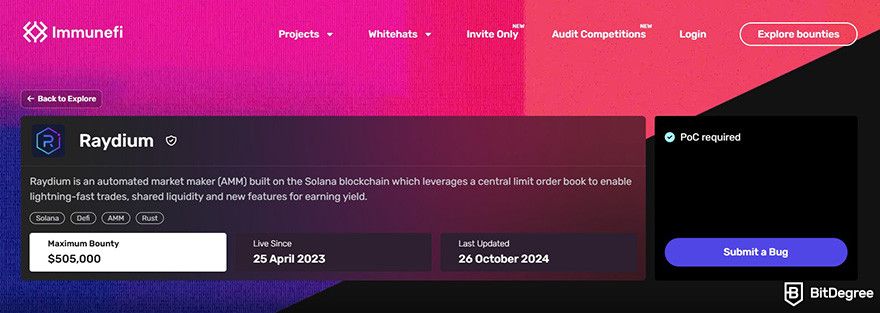
However, it is important to note that Raydium experienced a significant security incident on December 16, 2022. A private key compromise, caused by a trojan virus, allowed an attacker to access the protocol and drain several liquidity pools on Solana. Unfortunately, around $5.5 million worth of customer assets were stolen during this exploit.
At the end of the day, Raydium’s safety depends on how comfortable you are with taking responsibility for your trades and security. If you’re prepared for that, its transparent and decentralized nature can feel empowering. But always proceed with caution and double-check the details before diving in!

Did you know?
All Crypto Exchanges may look similar to you but they're NOT all the same!
Raydium Review: PROS
Raydium has gained a lot of popularity as a DEX, and there are plenty of reasons why users are drawn to it. In this Raydium review, let’s explore some of the platform’s standout features that make it a favorite among DeFi enthusiasts.
High Performance with Solana
One of the biggest advantages of the Raydium exchange is its incredible performance, thanks to being built on Solana. Solana is famous for its lightning-fast speeds, handling up to 65,000 transactions per second with a block time of just 400 milliseconds[2]. What’s even better? Transactions cost less than $0.01 on average. This kind of speed and affordability makes trading on Raydium feel seamless and efficient, even during peak times.
Unlike some other blockchains that struggle with congestion and high fees, Solana’s scalability ensures smooth operations for DEX platforms like Raydium, Orca, and Jupiter Exchange. It’s no wonder that Solana-based projects have become go-to options for DeFi enthusiasts who value speed and cost-effectiveness.

In this Raydium review, it’s clear that Solana gives the platform an edge over competitors built on slower or more expensive blockchains. Whether you’re swapping tokens, adding liquidity, or farming yields, the high performance makes everything quicker and cheaper. For those who love efficiency, this is a huge plus.
That said, if you’re diving into this Raydium exchange review, you’ll see that the platform doesn’t just rely on Solana’s performance—it combines it with innovative features to offer a standout DeFi experience.
Unique Hybrid AMM Design
Raydium exchange has a unique AMM design that sets it apart from traditional exchanges like Binance and Bybit. On traditional platforms, trading is done through an order book that matches buyers and sellers. But on automated market maker platforms like Raydium, trading happens directly with liquidity pools, removing the need for direct buyers or sellers.
What makes Raydium truly unique is how its AMM connects with OpenBook’s central limit order book. This means that Raydium users and liquidity pools have access to the order flow and liquidity of the entire OpenBook ecosystem, creating deeper liquidity and better pricing. It’s a hybrid approach that combines the best of both worlds—something you don’t see on most AMM platforms.
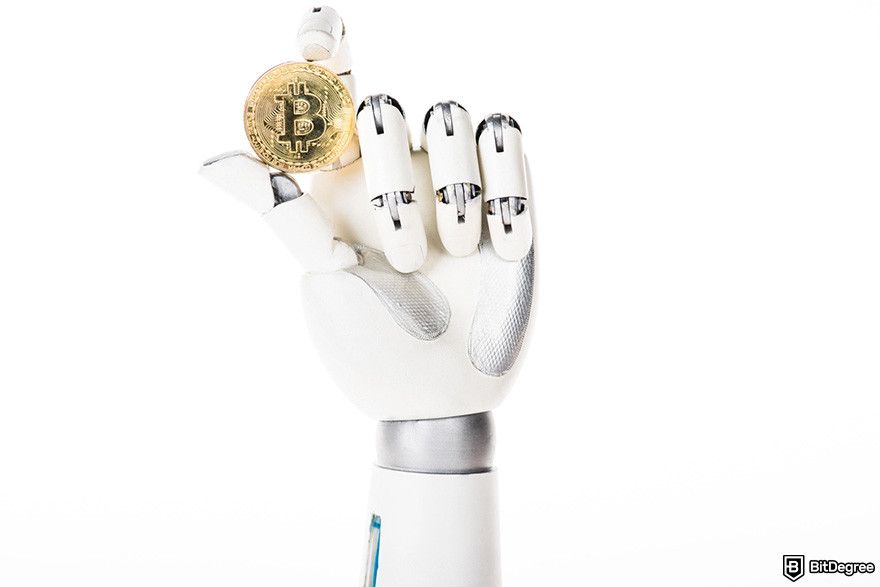
Raydium even goes the extra mile with its Best Price Swaps feature. When you make a trade, the platform automatically determines whether swapping within a liquidity pool or through the OpenBook order book will give you the best deal. This saves time and ensures you’re always getting the best price available.
If you’re diving into this Raydium review, or wondering how to trade on Raydium, this innovative AMM design is a key reason why it’s become a top choice for DeFi enthusiasts. It’s all about maximizing efficiency and value for users, and that’s something I truly appreciate.
Yield Opportunities
In addition to the standard swap feature, the Raydium exchange app also offers features that let users earn yield from their assets. Whether you’re a liquidity provider or a RAY token holder, Raydium has features that make earning yield pretty straightforward and rewarding.
If you’re into providing liquidity, Raydium offers a Concentrated Liquidity Market Maker (CLMM) feature. This allows users to earn fees based on the liquidity they provide within specific price ranges. The more liquidity you provide at the current price, the more fees you’ll earn in proportion to your share.
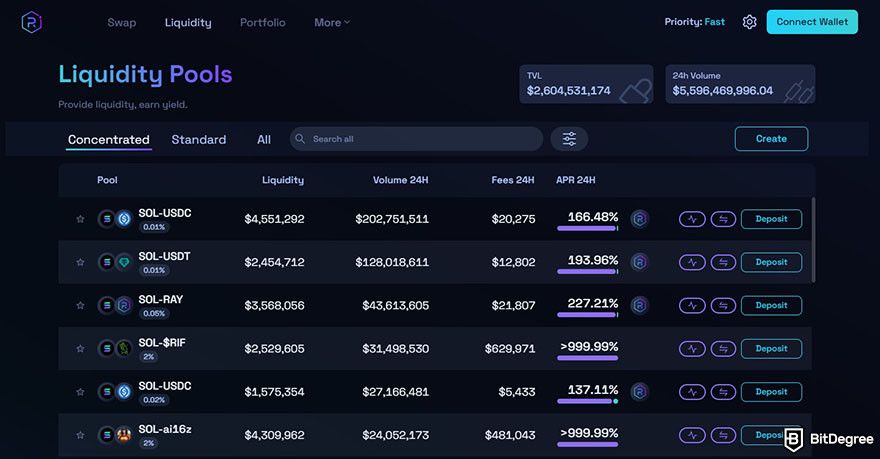
But here’s the catch: liquidity providers need to actively manage their positions to ensure the pool is trading within the selected price range. It’s not a set-it-and-forget-it deal, but if you’re willing to stay engaged, it can be pretty profitable.
Additionally, if you hold RAY tokens, you can earn even more by staking them. The Raydium exchange app makes it simple to stake your tokens and watch your holdings grow over time. This is a great way to earn passive income while holding onto your RAY tokens.
All of this makes Raydium’s earn features an attractive option for anyone looking to make the most of their assets. Whether you’re looking to provide liquidity or stake RAY tokens, there are plenty of ways to boost your earnings. If you’re curious about how these features work, I will discuss them in detail in later sections of this Raydium review!
Low Transaction Fees
When it comes to transaction fees, the Raydium exchange benefits from its foundation on the Solana blockchain. As I mentioned earlier, Solana is known for offering some of the lowest fees in the crypto world, which directly benefits Raydium users. Because Solana can process a massive number of transactions per second at a fraction of the cost compared to other networks, Raydium can keep its fees competitive and affordable.
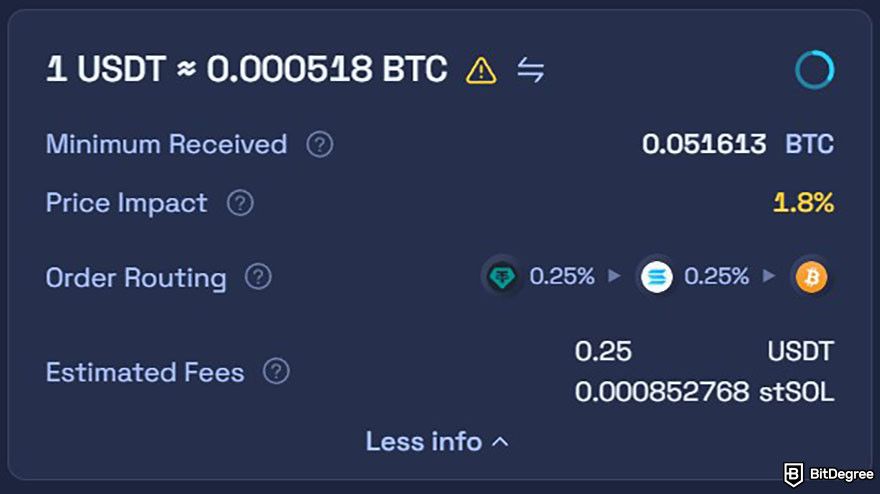
In fact, Raydium’s fees are among the most cost-effective in DEXs, making it a great option for traders who want to keep their costs down. Solana’s ability to handle high transaction volumes without compromising on speed or cost is one of the reasons why it’s so popular for developing dApps and participating in DeFi or NFT trading.
So, whether you're swapping tokens or interacting with liquidity pools, the fees are minimal, which is a huge benefit for anyone who trades frequently.
Extensive Educational Resources
New to DeFi or DEXs specifically? Don’t worry! Raydium provides an extensive documentation page covering various topics starting from what the topic is to more detailed guides on how to trade on Raydium.
This is a big deal for me personally who cares a lot about educating beginners. Decentralized exchanges are notoriously harder to navigate, especially for crypto beginners. That’s why Raydium’s comprehensive documentation page is a blessing that helps anyone use the platform easily.
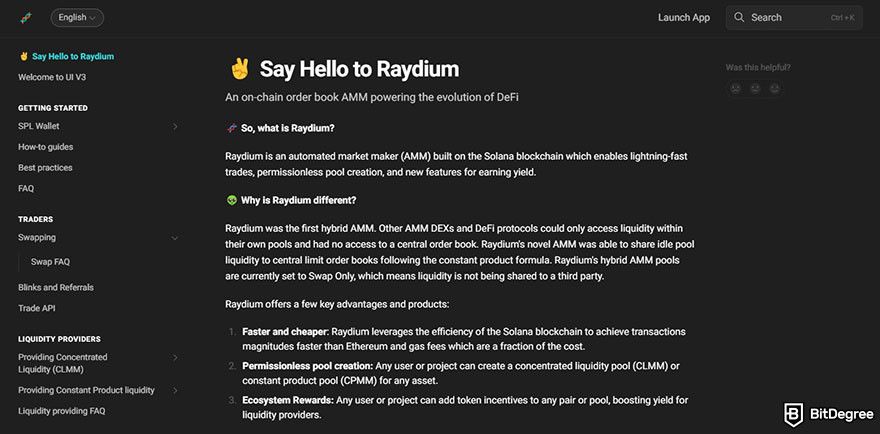
I really appreciate how easy it is to find exactly the content you need, without getting overwhelmed. The documentation is user-friendly and broken down into digestible sections that make learning at your own pace easy and stress-free. If you're confused about anything, you can usually find the answer there, which is such a relief!
I’ve seen a lot of platforms that fall short when it comes to user education. But, in this Raydium exchange review, I want to highlight how the platform’s documentation page stands out as one of its strongest points. It makes the whole experience smoother and more approachable, which is something I think all users, especially beginners, can appreciate.
Raydium Review: CONS
While Raydium offers a lot of great features, no platform is without its downsides and it’s important to consider both the pros and cons before diving into any exchange. So, let's explore some of the potential drawbacks of using this DEX in this part of the Raydium review and see what might be a dealbreaker for certain users.
Past Security Concerns
One of the cons I feel is worth mentioning in this Raydium review is the platform’s past security concerns. While Raydium has made strides in improving its security, it’s important to acknowledge that the platform experienced a notable security incident in December 2022.
A private key compromise, due to a trojan virus, led to the draining of several liquidity pools, with approximately $5.5 million worth of assets being stolen. This was a serious breach, and while it was unfortunate, the team took immediate steps to address the issue and reinforce security moving forward.

It’s also crucial to point out that Raydium currently offers no warranty or guarantees. When using the Raydium exchange app or interacting with its decentralized protocol, you are using the platform at your own risk. There’s no central authority overseeing transactions, so users are ultimately responsible for their own safety.
Raydium has made it clear that they won’t be held liable for any losses or damages resulting from using the platform, which can be a bit concerning for those who are new to DeFi or less familiar with the risks involved.
While Raydium has taken steps to improve security, it’s always a good idea to stay cautious, especially with any decentralized exchange, and ensure you understand the risks before diving in.
Limited Accessibility
Another downside I found while writing this Raydium review is the platform's limited accessibility. Unfortunately, Raydium isn't available for users in certain regions due to legal and regulatory restrictions. If you're a resident of places like Belarus, North Korea, Crimea, Iran, Syria, or even the United States, you won't be able to use the Raydium exchange app.

This can be quite frustrating for users in these regions who are eager to get involved with DeFi and enjoy the benefits Raydium offers, especially since it’s built on the fast and cost-effective Solana network. If you happen to live in one of these prohibited jurisdictions, you’ll have to look for alternative platforms to trade and participate in DeFi activities.
While Raydium’s global reach is impressive, this limitation does narrow the pool of potential users. It's always a good idea to double-check the platform's availability in your country to avoid any surprises when trying to access it.
Raydium Fees
Understanding the platform’s strong and weak points is not enough to make a fully educated decision on whether or not Raydium is the perfect fit for you. That’s why I want to highlight the fees associated with trading on Raydium to help you avoid unexpected charges if you decide to try this DEX out. Overall, Raydium offers a transparent fee structure with a clear description of where each portion of the fees will be distributed. Let’s take a look at the full breakdown.
Trading Fees for AMM Pools
For swaps made in Raydium’s AMM pools, there’s a standard trading fee of 0.25%. This fee is split up and used in different ways to benefit the platform and its users. Here's the breakdown:
- 0.03% (3 basis points) goes towards RAY buybacks, which helps reduce the supply of the RAY token and can positively impact its price.
- The remainder of the fee is used to incentivize liquidity providers (LPs) and fund the Raydium treasury.
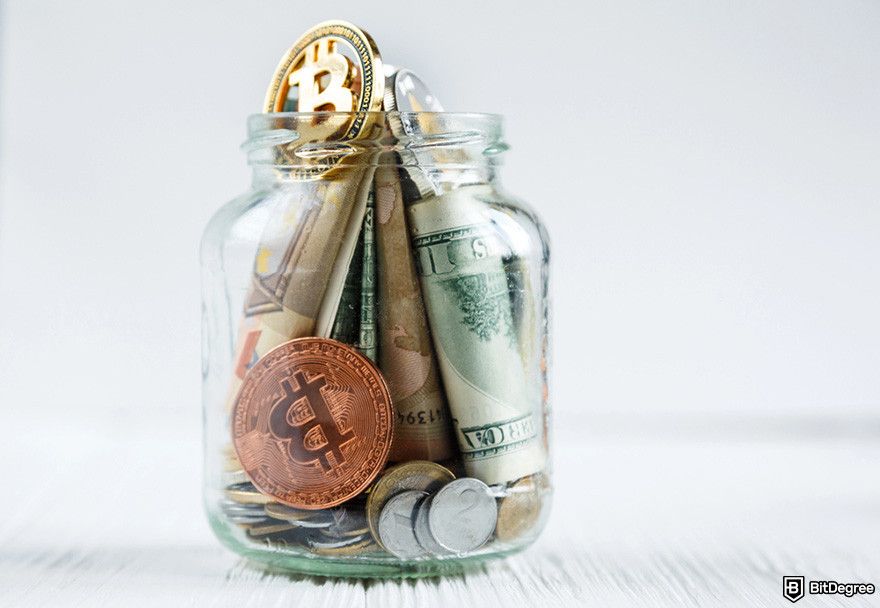
If you’re trading in AMM v4 pools, this fee is fixed at 0.25%, but when you trade in CP-Swap (CPMM) pools, the trading fee can vary. It can be set to one of four different fee tiers, ranging from 0.25% to 4% depending on the pool’s specific configuration. Here’s how the fees are distributed:
- 84% of the fee goes directly to liquidity providers as a reward for supplying liquidity.
- 12% is allocated to RAY buybacks.
- The final 4% is directed to the Raydium treasury, which helps with platform development and sustainability.
Concentrated Liquidity Pools (CLMM)
Raydium also offers Concentrated Liquidity (CLMM) pools, which are a bit more advanced but can be lucrative for liquidity providers. In these pools, the trading fee is dynamic and can be set to one of eight different fee tiers: 2%, 1%, 0.25%, 0.05%, 0.04%, 0.03%, 0.02%, and 0.01%.
The fee distribution is similar to the AMM pools, where liquidity providers earn 84% of the trading fee for every swap in the pool, 12% going to RAY buybacks, and the remaining 4% going to the treasury.

These fees are part of what makes Raydium an attractive option for both liquidity providers and traders. Liquidity providers can earn a good share of the fees, especially with concentrated liquidity, where they can manage their positions more actively to capture higher fees.
RAY Buybacks and Treasury
One of the standout features in this fee structure is the RAY buyback program, which helps support the value of the RAY token. Every swap on the platform contributes a small percentage towards buying back RAY tokens from the market. This helps create upward pressure on the price, benefiting RAY token holders in the long run.
The portion that goes to the treasury is used to fund the continued development of the platform. The treasury funds are essential for ensuring that the Raydium exchange remains competitive and secure in the long run.

I can say that the platform’s fees are quite competitive, especially given the value it offers. Moreover, the rewards for liquidity providers are solid, making it an attractive option for users who want to participate in DeFi. If you’re planning to use the Raydium exchange app, it’s good to keep in mind how these fees work to maximize your experience.
Raydium Features
Now that we’ve gone through the pros and cons as well as the fees associated with Raydium, it is time to explore what the platform has to offer in terms of trading features. In a nutshell, I’d say Raydium’s feature list is pretty barebones, especially compared to major CEXs, such as Binance and Kraken. However, it has certain elements that make it unique.
Standard Coin Swap
One of the most straightforward features you’ll find in this Raydium exchange review is the Standard Swap. A swap is essentially an exchange of one token for another, and on Raydium, this process is seamless, thanks to its smart contract technology built on Solana. Since swaps are executed directly against liquidity provided by depositors, there’s no need for intermediaries like on custodian exchanges. This makes trading faster, more secure, and decentralized.
Raydium’s liquidity comes from its own pools, and its routing engine does a fantastic job of finding the best execution price for your swaps. It can even route through multiple pools to minimize slippage, saving you money in the process. This can be a big advantage, especially when dealing with larger trades or less common tokens.
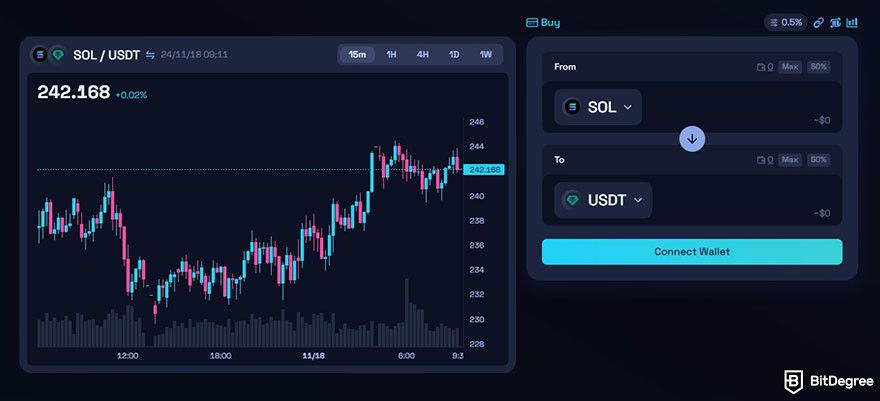
What I also like is that Raydium is a fully decentralized protocol where token listings are completely permissionless. This means that any project can create a pool and list its tokens, giving users access to a wide variety of trading options. That said, I always recommend double-checking the contract address before swapping on Raydium to ensure you’re dealing with the correct token. A little caution can go a long way in avoiding potential issues!
Concentrated Liquidity Pools
Aside from swapping tokens, Raydium users can also provide liquidity to various pools and earn yields. There are two types of liquidity pools in Raydium; Concentrated Liquidity Market Maker (CLMM) pool and standard Automated Market Maker (AMM) pool.
CLMM pools take liquidity provision to the next level. Unlike traditional AMM pools where liquidity is spread thinly across a price curve from zero to infinity, CLMM pools let liquidity providers (LPs) focus their resources within a specific price range. It’s like setting up shop only where you expect the most foot traffic—this strategy allows LPs to use their capital more efficiently and earn higher yields from trading fees.
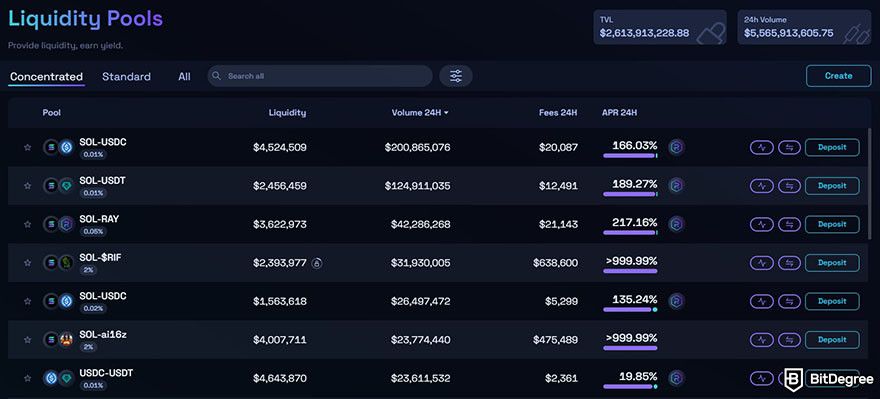
Here’s how it works: when you add liquidity to a CLMM pool, you decide the price range in which your funds will be active. If trades happen within that range, you earn fees proportional to your share of liquidity at that price. However, if the price of the token moves outside your selected range, your position stops earning fees, and your liquidity sits idle. Worse, you could face impermanent loss, which is when the value of your holdings decreases compared to simply holding the tokens.
Because of this, actively managing your positions is key to maximizing returns and minimizing risks. I’d recommend anyone diving into CLMM pools to fully understand concepts like impermanent loss. Trust me, a little preparation can save you from potential headaches later. It’s a powerful feature, but one that rewards informed decisions.
RAY Staking
Another feature worth highlighting in this Raydium review is the platform’s staking feature. Yes, Raydium has a utility token (RAY) and you can stake it to earn an additional RAY yield. At the time of writing this article, the token’s liquidity is at $251,054,313.93 with 4.5% APR if you stake it.

This staking feature is a great addition to the platform because it allows users to passively grow their holdings while contributing to the ecosystem’s stability. By staking RAY, you’re not only earning rewards but also helping to secure the platform and incentivize liquidity. The 4.5% APR might not be the highest in the DeFi space, but it’s a solid option for those looking for steady, low-risk returns.
What I particularly like about this feature is its simplicity—staking RAY doesn’t require advanced technical knowledge, making it accessible even to newcomers. Plus, with the staking process fully integrated into the Raydium exchange app, it’s easy to start earning with just a few clicks.
How to Trade on Raydium
After reading this Raydium review, some of you might be interested in trying out the platform yourself. If that’s the case, here is a brief step-by-step guide on how to trade on Raydium to help you get started with this decentralized exchange:
Step 1: Visit the Raydium website and connect your wallet. There are multiple Raydium wallet options you can choose including Phantom, Solflare, and even Ledger hardware wallets.
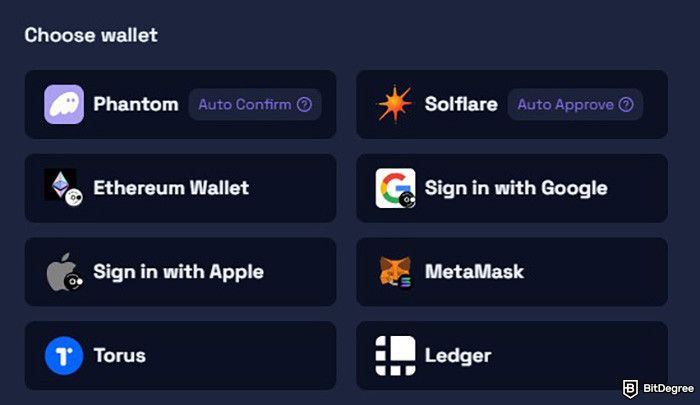
Step 2: Select the token you want to swap from the drop-down menu. Alternatively, you can paste the token mint address in the available field.
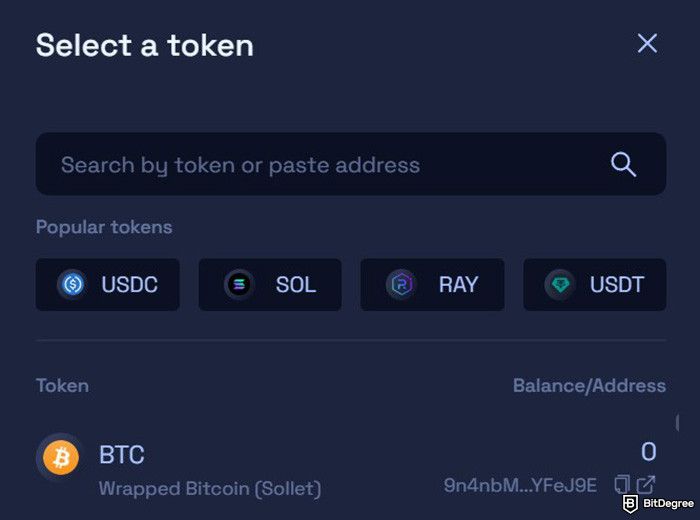
Step 3: Enter the amount of tokens you want to swap or receive.
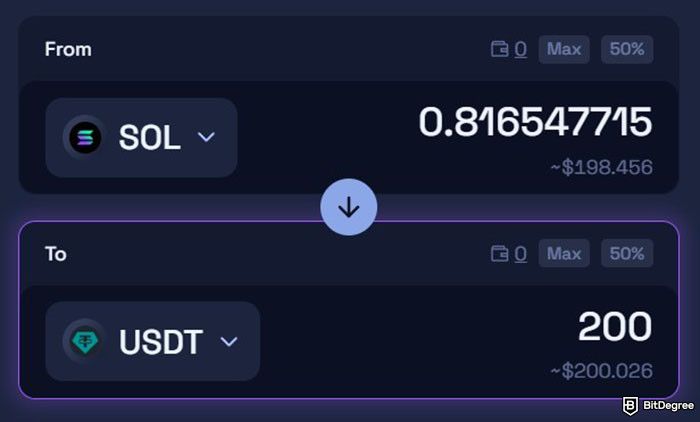
Step 4: To increase your transaction's chance of being processed quickly, you can adjust the “Priority” fee in the top right corner. Please note that higher fees don't guarantee immediate confirmation. Once you’re done, click “Swap”.
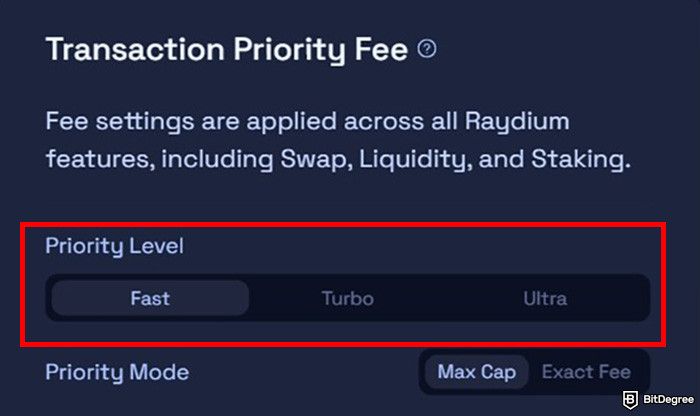
Step 5: Your new balance should appear shortly after the transaction is confirmed.

- Secure and reliable
- Accepts fiat currencies
- Lots of trading options
- Reputable exchange
- Accepts fiat currencies
- Offers various trading options

- Huge trading variety
- Regulation-compliant around the globe
- Fair trading fees
- Beginner-friendly
- A wide array of features
- Vast number of different crypto coins & tokens

- Beginner-friendly
- Secure
- Decent trading and withdrawal fees
- Crypto.com Visa Card
- Automated tools & bots
- Ecosystem synergy with CRO
Conclusions
To wrap up this Raydium review, I think it’s clear that Raydium is a standout platform in the decentralized exchange space. Its unique AMM design, integrated with OpenBook’s order book, offers users better liquidity and pricing. Features like concentrated liquidity pools and staking opportunities for RAY holders provide earning potential and highlight the platform’s versatility. Additionally, the extensive documentation makes navigating the platform much easier, especially for those new to DeFi.
That said, Raydium isn’t without its challenges. Limited accessibility for users in certain regions and past security concerns might raise red flags for some. If you live in a country where Raydium is restricted, popular exchanges like Binance, Kraken, and Bybit can be good options. And while its fees are competitive, understanding how to optimize them—whether through staking, providing liquidity, or simply swapping tokens—requires careful consideration.
Ultimately, if you’re someone who values innovative features, low fees, and a user-friendly experience, Raydium is worth exploring. For those wondering how to trade on Raydium, the platform's straightforward interface, and permissionless token listings make it simple to get started. Just remember to do your due diligence and stay informed about the risks of DeFi platforms. Raydium has a lot to offer, and with the right approach, it can be a valuable tool in your crypto toolkit.
The content published on this website is not aimed to give any kind of financial, investment, trading, or any other form of advice. BitDegree.org does not endorse or suggest you to buy, sell or hold any kind of cryptocurrency. Before making financial investment decisions, do consult your financial advisor.
Scientific References
1. Mohan V.: Automated Market Makers and Decentralized Exchanges: a DeFi Primer;
2. Busayatananphon C., Boonchieng E.: Financial Technology DeFi Protocol: A Review.


